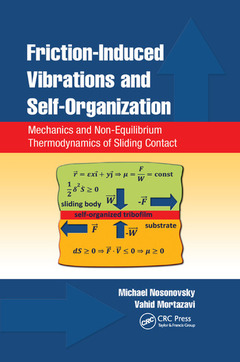Friction-Induced Vibrations and Self-Organization Mechanics and Non-Equilibrium Thermodynamics of Sliding Contact
Auteurs : Nosonovsky Michael, Mortazavi Vahid

Many scientists and engineers do not realize that, under certain conditions, friction can lead to the formation of new structures at the interface, including in situ tribofilms and various patterns. In turn, these structures?usually formed by destabilization of the stationary sliding regime?can lead to the reduction of friction and wear. Friction-Induced Vibrations and Self-Organization: Mechanics and Non-Equilibrium Thermodynamics of Sliding Contact combines the mechanical and thermodynamic methods in tribology, thus extending the field of mechanical friction-induced vibrations to non-mechanical instabilities and self-organization processes at the frictional interface. The book also relates friction-induced self-organization to novel biomimetic materials, such as self-lubricating, self-cleaning, and self-healing materials.
Explore Friction from a Different Angle?as a Fundamental Force of Nature
The book begins with an exploration of friction as a fundamental force of nature throughout the history of science. It then introduces general concepts related to vibrations, instabilities, and self-organization in the bulk of materials and at the interface. After presenting the principles of non-equilibrium thermodynamics as they apply to the interface, the book formulates the laws of friction and highlights important implications. The authors also analyze wear and lubrication. They then turn their attention to various types of friction-induced vibration, and practical situations and applications where these vibrations are important. The final chapters consider various types of friction-induced self-organization and how these effects can be used for novel self-lubricating, self-cleaning, and self-healing materials.
From Frictional Instabilities to Friction-Induced Self-Organization
Drawing on the authors? original research, this book presents a new, twenty-first century perspective on friction and tribology. It shows how friction-induced instabilities and vibrations can lead to self-organized structures, and how understanding the structure?property relationships that lead to self-organization is key to designing "smart" biomimetic materials.
Introduction: Friction as a Fundamental Force of Nature in the History of Mechanics. Vibrations and Stability at the Bulk and at the Interface. Principles of Non-Equilibrium Thermodynamics and Friction. Fundamentals of Friction. Wear and Lubrication. Friction-Induced Instabilities and Vibrations. Friction-Induced Vibrations and Their Applications. From Frictional Instabilities to Friction-Induced Self-Organization. Self-Lubrication. Outlook. Index.
Michael Nosonovsky is an assistant professor at the University of Wisconsin-Milwaukee. He received his M.Sc. from St. Petersburg Polytechnic University, Russia, and his Ph.D. in mechanical engineering from Northeastern University, Boston. He has also worked at Ohio State University and the National Institute of Standards and Technology. Michael’s interests include biomimetic surfaces, capillary effects, nanotribology, and friction-induced self-organization.
Vahid Mortazavi is a doctoral student at the University of Wisconsin-Milwaukee. He received his M.Sc. from Tarbiat Modares University in Tehran, Iran. Vahid’s research interests include friction, tribology, and heat transfer.
Date de parution : 11-2017
15.6x23.4 cm
Disponible chez l'éditeur (délai d'approvisionnement : 14 jours).
Prix indicatif 111,58 €
Ajouter au panierDate de parution : 07-2013
Ouvrage de 312 p.
15.6x23.4 cm
Disponible chez l'éditeur (délai d'approvisionnement : 15 jours).
Prix indicatif 293,12 €
Ajouter au panierThèmes de Friction-Induced Vibrations and Self-Organization :
Mots-clés :
Stick Slip Motion; Copyright American Chemical Society; friction-induced vibrations; Frictional Sliding; friction-induced self-organization; Entropy Production; self-lubricating materials; Tribofilm Formation; non-equilibrium thermodynamics; Thermoelastic Instabilities; self-organization; Frictional Instabilities; biomimetics; Disk Brakes; biomimetic materials; Non-linear Vibrations; nanotribology; Sliding Velocity; tribology; GRW; friction and wear; Rayleigh Wave; WS2 Nano Particles; Nano Composite Coatings; Relative Slip Velocity; CaF2 Content; Elastic Half Spaces; Wear Debris; Self-lubricating Effect; Rayleigh Wave Speeds; Adhesion Hysteresis; Self-lubricating Composites; Shear Waves; Interface Friction Coefficient



